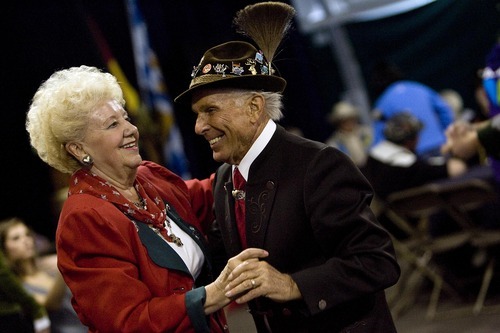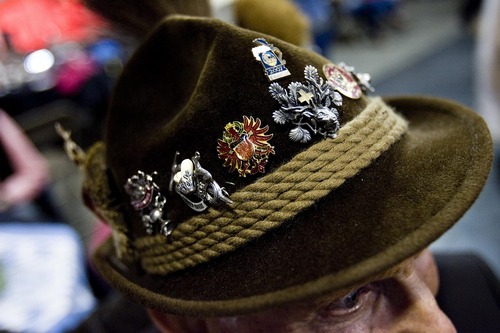This is an archived article that was published on sltrib.com in 2011, and information in the article may be outdated. It is provided only for personal research purposes and may not be reprinted.
Young, beer-swigging Utahns weren't the only ones to bid auf Wiedersehen to Snowbird's Oktoberfest on Sunday.
A small but colorfully dressed contingent of German-born Utahns — a group that's faithfully been attending almost every weekend of the festival for 39 years — also came to celebrate at the event, which made its last stand against the encroaching winter Sunday.
"It's fun for us to get dressed up so we can support the German community," said Fred Schwemmer, of Murray, who said he is one of about 15 or 20 German-born Utahns who have been attending the festival together for nearly four decades.
Schwemmer, like several of the others in the group, wore traditional Bavarian garb, including a green Tyrolean hat covered with pins representing towns and cities in Germany and a brush-like goat spear, sticking up near the back. Schwemmer kept warm with a gray, wool Bavarian coat, one of four such outfits he wears during festival season — not much compared to his wife's 14 traditional outfits that she wears each Oktoberfest.
"We're always looking forward to being able to dance," said Schwemmer, 78, shortly before whisking his wife, Hilde Schwemmer, 72, to the dance floor to waltz to the accordion-heavy sounds of live German folk music.
"All the mountains are beautiful here," said Hilde, who moved here with her husband in 1961. "It reminds me of home."
Snowbird's likeness to the mountains of Bavaria is part of what first led to the creation of Oktoberfest in Utah about 39 years ago. It was around then that some, including Berny Meng, now 81, of Holladay, started visiting the place for the event. It is typically held in Germany for about 17 days each fall and started in 1810 to celebrate the marriage of Bavarian Crown Prince Ludwig and Princess Therese von Sachsen-Hildburghausen.
"This tent was just a big pit of mud," Meng said of the area where the huge Snowbird beer tent now stands selling sauerkraut, spatzle, beef rouladen and hefty steins holding 34 ounces of beer each.
He said when he first started coming to Snowbird, one of the other Germans told him no one would come because no one liked the music they played. Meng told him, "That remains to be seen."
The event eventually grew into the eight-weekend-long Oktoberfest of today. The festival drew more than 50,000 people this year, said Emily Moench, Snowbird communications manager.
"Ever since we started," Meng said of Oktoberfest, "we've gotten bigger and bigger and bigger."
Meng, who moved to Utah from Germany in 1953, said the Snowbird festival reminds him of those in Germany — except for the dancing.
"You meet your friends and you can talk about what you experienced in the old country," said Meng, clad in a green suit, Tyrolean hat and Bavarian tie covered in white edelweiss flowers, which are found in the Alps and, he said, symbolize bravery.
Though Meng looks forward to Oktoberfest each year, he agreed that Sunday was a proper time to stop for this season, noting the already-accumulating snow in the mountains.









